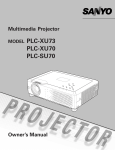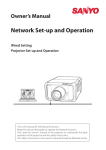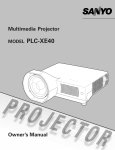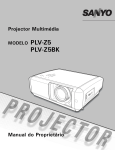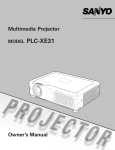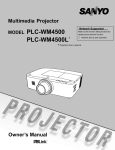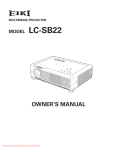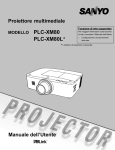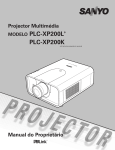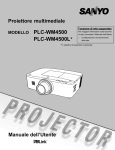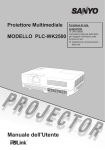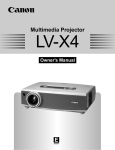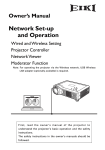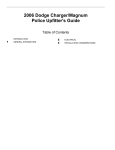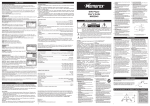Download Sanyo PLC-XW50 User's Manual
Transcript
Multimedia Projector MODEL PLC-XW50 PLC-XW55 Owner's Manual Features and Design This Multimedia Projector is designed with the most advanced technology for portability, durability, and ease of use. This projector utilizes built-in multimedia features, a palette of 16.77 million colors, and matrix liquid crystal display (LCD) technology. ◆ Compact Design ◆ Multilanguage Menu Display This projector is designed compact in size and weight. It is easy to carry and work anywhere you wish to use. ◆ Compatibility The projector widely accepts various video and computer input signals including: C o m p u t e r s , 6 C o l o r s y s t e m s ( PA L , SECAM, NTSC, NTSC4.43, PAL-M, and PAL-N), Component video, S-Video and RGB scart. ◆ Logo Function ◆ Simple Computer System Setting The projector has the Multi-scan system to conform to almost all computer output signals quickly. (p.26) The digital zoom function expands (to approx. 16 times of the screen size) the image size, allowing you to focus on crucial information during the presentation. (p.33) The Logo function allows you to customize the screen logo with the Logo functions. (p.42-44) You can capture an image for the screen logo, choose a logo between provided and captured. ◆ Power Management ◆ Digital Zoom (for Computer) Operation menu is available in 16 languages: English, German, French, Italian, Spanish, Portuguese, Dutch, Swedish, Finnish, Polish, Hungarian, Romanian, Russian, Chinese, Korean, and Japanese. (p.41) The Power management function reduces power consumption and maintains the lamp life. (p.46) ◆ Lamp Control Brightness of the projection lamp can be selected. (p.47) ◆ Noise Reduction function ◆ Security Function The Noise reduction function helps you to reduce the contained noise on the screen to get smoother images. (p.39) ◆ Blackboard Function Blackboard* can be used as a projection screen. *The board color is limited to Green. (p.30, 37) ◆ Input Search Function ✔ Note: The Security function helps you to ensure the security with the Key lock (p.48) and the PIN code lock (p.18, 48, 49) functions. You can lock the operation on the projector and the remote control. Also you can prevent unauthorized persons from using the projector. Input signal can be searched automatically. (p.45) •The On-Screen Menu and figures in this manual may differ slightly from the product. •The contents of this manual are subject to change without notice. Table of Contents Features and Design . . . . . . . . . . . . . 2 Table of Contents . . . . . . . . . . . . . . . 3 To the Owner . . . . . . . . . . . . . . . . . . . 4 Safety Instructions . . . . . . . . . . . . . . 5 Air Circulation 6 Installing the Projector in Proper Position 6 Moving the Projector 6 Compliance . . . . . . . . . . . . . . . . . . . . 7 Part Names and Functions . . . . . . . . 8 Front Back 8 8 Rear Terminal Top Control Remote Control Remote Control Battery Installation Operating Range 9 10 11 12 12 Bottom 8 Installation . . . . . . . . . . . . . . . . . . . . . 13 Positioning the Projector Adjustable Foot Connecting the AC Power Cord Connecting to a Computer Connecting to Video Equipment Connecting to Component Video Equipment 13 13 14 15 16 17 Basic Operation . . . . . . . . . . . . . . . . . 18 Turning On the Projector 18 Turning Off the Projector 19 How to Operate the On-Screen Menu20 Menu Bar21 Zoom Adjustment22 Screen Position Adjustment22 Focus Adjustment22 Keystone Correction22 Sound Adjustment23 Remote Control Operation23 Computer Input . . . . . . . . . . . . . . . . . 25 Input Source Selection25 Computer System Selection26 Auto PC Adjustment27 Manual PC Adjustment28 Image Level Selection 30 Image Level Adjustment 31 Screen Size Adjustment 32 Video Input . . . . . . . . . . . . . . . . . . . . . 34 Input Source Selection (Video) Input Source Selection (S-Video, Component, RGB Scart 21-pin) Video System Selection Image Level Selection Image Level Adjustment Screen Size Adjustment 34 Setting 41 Warning Indicator Cleaning the Air Filters Slide Shutter Cleaning the Projection Lens Cleaning the Projector Cabinet Lamp Replacement Lamp Replacement Counter 51 52 52 53 53 54 55 Troubleshooting Menu Tree Indicators and Projector Condition Compatible Computer Specifications Technical Specifications Optional Parts Configurations of Terminals PIN Code Number Memo 56 58 60 61 62 63 64 65 35 36 37 38 40 Setting . . . . . . . . . . . . . . . . . . . . . . . . 41 Maintenance and Cleaning . . . . . . . . 51 Appendix . . . . . . . . . . . . . . . . . . . . . . 56 Trademarks Each name of corporations or products in this book is either a registered trademark or a trademark of its respective corporation. To the Owner Before operating this projector, read this manual thoroughly and operate the projector properly. This projector provides many convenient features and functions. Operating the projector properly enables you to manage those features and maintains it in better condition for a considerable time. Improper operation may result in not only shortening the product-life, but also malfunctions, fire hazard, or other accidents. If your projector seems to operate improperly, read this manual again, check operations and cable connections and try the solutions in the "Troubleshooting" section on pages 56-57 of this manual. If the problem still persists, contact the dealer where you purchased the projector or the service center. CAUTION RISK OF ELECTRIC SHOCK DO NOT OPEN CAUTION: TO REDUCE THE RISK OF ELECTRIC SHOCK, DO NOT REMOVE COVER (OR BACK). NO USER-SERVICEABLE PARTS INSIDE EXCEPT LAMP REPLACEMENT. REFER SERVICING TO QUALIFIED SERVICE PERSONNEL. THIS SYMBOL INDICATES THAT DANGEROUS VOLTAGE CONSTITUTING A RISK OF ELECTRIC SHOCK IS PRESENT WITHIN THIS UNIT. THIS SYMBOL INDICATES THAT THERE ARE IMPORTANT OPERATING AND MAINTENANCE INSTRUCTIONS IN THE OWNER'S MANUAL WITH THIS UNIT. NOTE:This symbol and recycle system are applied to EU countries only and not applied to the countries in the other area of the world. Your SANYO product is designed and manufactured with high quality materials and components which can be recycled and reused. This symbol means that electrical and electronic equipment, at their end-of-life, should be disposed of separately from your household waste. Please dispose of this equipment at your local community waste collection/recycling centre. In the European Union there are separate collection systems for used electrical and electronic products. Please help us to conserve the environment we live in! WARNING: Safety Precaution TO REDUCE THE RISK OF FIRE OR ELECTRIC SHOCK, DO NOT EXPOSE THIS APPLIANCE TO RAIN OR MOISTURE. – This projector produces intense light from the projection lens. Do not stare directly into the lens as much as possible. Eye damage could result. Be especially careful that children do not stare directly into the beam. – Install the projector in a proper position. If not, it may result in a fire hazard. – Allowing the proper amount of space on the top, sides, and rear of the projector is critical for proper air circulation and cooling of the unit. The dimensions shown here indicate the minimum space required. If the projector is to be built into a compartment or similarly enclosed, these minimum distances must be maintained. – Do not cover the ventilation slot on the projector. Heat build-up can reduce the service life of your projector, and can also be dangerous. SIDE and TOP REAR 0.7'(0cm) 1.5'(50cm) 3'(1m) 1.5'(50cm) – If the projector is not to be used for an extended time, unplug the projector from the power outlet. CAUTION ON HANGING FROM THE CEILING When hanging the projector from the ceiling, clean air intake vents, air filters, or top of the projector periodically with a vacuum cleaner. If you leave the projector unclean for a long time, the dust will block the operation of the cooling function, and it may cause a breakdown or a disaster. Do not set the projector in greasy, wet, or smoky conditions such as IN a kitchen to prevent A Breakdown or a disaster. If The PROJECTor comes in contact with oil or chemicals, IT may become deteriorated. CAUTION Not for use in a computer room as defined in the Standard for the Protection of Electronic Computer/ Data Processing Equipment, ANSI/NFPA 75. Ne peut être utilisé dans une salle d’ordinateurs telle que définie dans la norme ANSI/NFPA 75 Standard for Protection of Electronic Computer/Data Processing Equipment. READ AND KEEP THIS OWNER'S MANUAL FOR LATER USE. Safety Instructions All the safety and operating instructions should be read before the product is operated. Read all of the instructions given here and retain them for later use. Unplug this projector from AC power supply before cleaning. Do not use liquid or aerosol cleaners. Use a damp cloth for cleaning. Follow all warnings and instructions marked on the projector. For added protection to the projector during a lightning storm, or when it is left unattended and unused for long periods of time, unplug it from the wall outlet. This will prevent damage due to lightning and power line surges. Do not expose this unit to rain or use near water... for example, in a wet basement, near a swimming pool, etc... Do not use attachments not recommended by the manufacturer as they may cause hazards. Do not place this projector on an unstable cart, stand, or table. The projector may fall, causing serious injury to a child or adult, and serious damage to the projector. Use only with a cart or stand recommended by the manufacturer, or sold with the projector. Wall or shelf mounting should follow the manufacturer's instructions, and should use a mounting kit approved by the manufacturers. An appliance and cart combination should be moved with care. Quick stops, excessive force, and uneven surfaces may cause the appliance and cart combination to overturn. Slots and openings in the back and bottom of the cabinet are provided for ventilation, to ensure reliable operation of the equipment and to protect it from overheating. The openings should never be covered with cloth or other materials, and the bottom opening should not be blocked by placing the projector on a bed, sofa, rug, or other similar surface. This projector should never be placed near or over a radiator or heat register. Do not install the projector near the ventilation duct of air-conditioning equipment. This projector should be operated only from the type of power source indicated on the marking label. If you are not sure of the type of power supplied, consult your authorized dealer or local power company. Do not overload wall outlets and extension cords as this can result in fire or electric shock. Do not allow anything to rest on the power cord. Do not locate this projector where the cord may be damaged by persons walking on it. Do not attempt to service this projector yourself as opening or removing covers may expose you to dangerous voltage or other hazards. Refer all servicing to qualified service personnel. Unplug this projector from wall outlet and refer servicing to qualified service personnel under the following conditions: a.When the power cord or plug is damaged or frayed. b.If liquid has been spilled into the projector. c.If the projector has been exposed to rain or water. d.If the projector does not operate normally by following the operating instructions. Adjust only those controls that are covered by the operating instructions as improper adjustment of other controls may result in damage and will often require extensive work by a qualified technician to restore the projector to normal operation. e.If the projector has been dropped or the cabinet has been damaged. f.When the projector exhibits a distinct change in performance-this indicates a need for service. When replacement parts are required, be sure the service technician has used replacement parts specified by the manufacturer that have the same characteristics as the original part. Unauthorized substitutions may result in fire, electric shock, or injury to persons. Upon completion of any service or repairs to this projector, ask the service technician to perform routine safety checks to determine that the projector is in safe operating condition. Voor de klanten in Nederland This projector should not be placed in a builtin installation such as a book case unless proper ventilation is provided. Never push objects of any kind into this projector through cabinet slots as they may touch dangerous voltage points or short out parts that could result in a fire or electric shock. Never spill liquid of any kind on the projector. NL Bij dit produkt zijn batterijen geleverd. Wanneer deze leeg zijn, moet u ze niet weggooien maar inleveren als KCA. Safety Instructions Air Circulation Openings in the cabinet are provided for ventilation and to ensure reliable operation of the product and to protect it from overheating, and these openings must not be blocked or covered. CAUTION Installing the Projector in Proper Position Install the projector properly. Improper Installation may reduce the lamp life and cause a fire hazard. 20˚ Hot air is exhausted from the exhaust vent. When using or installing the projector, the following precautions should be taken. –Do not put any flammable object or spray can near the projector, hot air is exhausted from the ventilation holes. –Keep the exhaust vent at least 3' (1 m) away from any objects. –Do not touch a peripheral part of the exhaust vent, especially screws and metallic part. This area will become hot while the projector is being used. –Do not put anything on the cabinet. Objects put on the cabinet will not only get damaged but also cause fire hazard by heat. Cooling fans are provided to cool down the projector. The fans’ running speed is changed according to the temperature inside the projector. Do not tilt the projector more than 20 degrees from side to side. 20˚ Do not point the projector up to project an image. Do not point the projector down to project an image. Do not put the projector on either side to project an image. Moving the Projector Air Intake Vent Air Intake Vent Exhaust Vent (Hot air exhaust) Air Intake Vent Exhaust Vent (Hot air exhaust) When moving the projector, close the lens shutter and retract the adjustable foot to prevent damage to the lens and cabinet. When the projector is not in use for an extended period, put it into a suitable case to protect the projector. When handling the projector, do not drop, bump, subject it to strong forces, or put other things on the cabinet. USE CAUTION IN CARRYING OR TRANSPORTING THE PROJECTOR –Do not drop or bump the projector, otherwise damages or malfunctions may result. –When carrying the projector, use a suitable carrying case. –Do not transport the projector by using a courier or transport service in an unsuitable transport case. This may cause damage to the projector. To transport the projector through a courier or transport service, consult your dealer for their information. –Do not put the projector in a case before the projector is cooled enough. Compliance Federal Communication Commission Notice Note: This equipment has been tested and found to comply with the limits for a Class B digital device, pursuant to Part 15 of the FCC Rules. These limits are designed to provide reasonable protection against harmful interference in a residential installation. This equipment generates, uses, and can radiate radio frequency energy, and if not installed and used in accordance with the instructions, may cause harmful interference to radio communications. However, there is no guarantee that interference will not occur in a particular installation. If this equipment does cause harmful interference to radio or television reception, which can be determined by turning the equipment off and on, the user is encouraged to try to correct the interference by one or more of the following measures: –Reorient or relocate the receiving antenna. –Increase the separation between the equipment and receiver. –Connect the equipment into an outlet on a circuit different from that to which the receiver is connected. –Consult the dealer or an experienced radio/TV technician for help. Use of shielded cable is required to comply with class B limits in Subpart B of Part 15 of FCC Rules. Do not make any changes or modifications to the equipment unless otherwise specified in the instructions. If such changes or modifications should be made, you could be required to stop operation of the equipment. Model Number : PLC-XW50/PLC-XW55 Trade Name : Sanyo Responsible party : SANYO FISHER COMPANY Address : 21605 Plummer Street, Chatsworth, California 91311 Telephone No. : (818)998-7322 AC Power Cord Requirement The AC Power Cord supplied with this projector meets the requirement for use in the country you purchased it. AC Power Cord for the United States and Canada: AC Power Cord used in the United States and Canada is listed by the Underwriters Laboratories (UL) and certified by the Canadian Standard Association (CSA). AC Power Cord has a grounding-type AC line plug. This is a safety feature to be sure that the plug will fit into the power outlet. Do not try to defeat this safety feature. Should you be unable to insert the plug into the outlet, contact your electrician. GROUND AC Power Cord for the United Kingdom: This cord is already fitted with a moulded plug incorporating a fuse, the value of which is indicated on the pin face of the plug. Should the fuse need to be replaced, an ASTA approved BS 1362 fuse must be used of the same rating, marked thus . If the fuse cover is detachable, never use the plug with the cover omitted. If a replacement fuse cover is required, ensure it is of the same colour as that visible on the pin face of the plug (i.e. red or orange). Fuse covers are available from the Parts Department indicated in your User Instructions. If the plug supplied is not suitable for your socket outlet, it should be cut off and destroyed. The end of the flexible cord should be suitably prepared and the correct plug fitted. (See Over) WARNING : A PLUG WITH BARED FLEXIBLE CORD IS HAZARDOUS IF ENGAGED IN A LIVE SOCKET OUTLET. The Wires in this mains lead are coloured in accordance with the following code: Green-and-yellow . . . . . . . Earth Blue . . . . . . . . . . . . . . . . . Neutral Brown . . . . . . . . . . . . . . . . Live As the colours of the wires in the mains lead of this apparatus may not correspond with the coloured markings identifying the terminals in your plug proceed as follows: The wire which is coloured green-and-yellow must be connected to the terminal in the plug which is marked by the letter E or by the safety earth symbol or coloured green or green-and-yellow. The wire which is coloured blue must be connected to the terminal which is marked with the letter N or coloured black. The wire which is coloured brown must be connected to the terminal which is marked with the letter L or coloured red. WARNING: THIS APPARATUS MUST BE EARTHED. ASA THE SOCKET-OUTLET SHOULD BE INSTALLED NEAR THE EQUIPMENT AND EASILY ACCESSIBLE. Part Names and Functions Front q Speaker w Focus Ring e Infrared Remote Receiver r Projection Lens t Slide Shutter (See page 52.) ySlide Shutter Lever uAir Intake Vent q wer t y i Exhaust Vents u CAUTION Back i i o !0 !1 u Hot air is exhausted from the exhaust vent. Do not put heat-sensitive objects near this side. o Power Cord Connector !0 Top Controls and Indicators !1 Terminals and Connectors !2 Air Intake Vents (back and bottom) !3 Adjustable Foot !4 Lamp Cover !5 Air Filters ✽ ✽ Kensington Security Slot This slot is for a Kensington lock used to deter theft of the projector. Bottom *Kensington is a registered trademark of ACCO Brands Corporation. !2 !3 !5 !4 i Part Names and Functions q w e r t Part Names and Functions Rear Terminal y u q SERVICE PORT This jack is used to service the projector. w COMPUTER IN /S-VIDEO IN /COMPONENT IN Connect output signal from a computer, RGB scart 21-pin video output, S-VIDEO output, or component video output to this terminal. (p.15-17) y VIDEO IN Connect the composite video output from video equipment to VIDEO jack. (p.16) u AUDIO IN Connect the audio output from video equipment connected to w or y to this jack. (When the audio output is monaural, connect it to L (MONO) jack.) (p.16) e MONITOR OUT This terminal can be used to output the incoming signal from COMPUTER IN/ S-VIDEO IN/COMPONENT IN terminal to the other monitor. (p.15, 17) r AUDIO OUT (VARIABLE) Connect an external audio amplifier to this jack. (p.15 - 17) This terminal outputs sound from AUDIO IN terminal (t or u). t COMPONENT/ COMPUTER AUDIO IN Connect the audio output (stereo) from a computer or video equipment connected to w to this jack. (p.15, 17) Part Names and Functions Top Control u y t r e w i o q q MENU button Open or close the On-Screen Menu. (p.20) w KEYSTONE ed buttons ✽ Correct the keystone distortion. (p.22, 41) u LAMP REPLACE indicator Turn yellow when the life of the projection lamp draws to an end. (p.54, 60) i ZOOM +/- (7 8) buttons ✽ Adjust the screen size. (p.22, 41) r POWER ON/STAND-BY button –Execute the selected item. (p.20) –Expand or compress the image in Digital zoom mode. (p.33) tPOWER indicator ✽ POINT (ed7 8) buttons eINPUT button Select input source. (p.25, 34, 35) Turn the projector on or off. (p.18, 19) Emit a red light until the projector gets ready to be turned on. It turns red when the projector is in the stand-by mode. It remains green while the projector is under operation. (p.18, 19, 60) y WARNING indicator 10 Emit a red light when the projector detects an abnormal condition. This also blinks red when the internal temperature of the projector exceeds the operating range. (p.51, 60) o SELECT button w and i can be used as the point (ed7 8) –Select an item or adjust the value in the On-Screen Menu. (p.20) –Pan the image in Digital zoom + mode. (p.33) buttons. Part Names and Functions Part Names and Functions Remote Control q POWER ON/STAND-BY button e w Turn the projector on or off. (p.18, 19) Select VIDEO input source. (p.23, 34) Select COMPUTER input source. (p.23, 25, 35) Open or close the On-Screen Menu. (p20) w VIDEO button q e COMPUTER button r MENU button t Point ed 7 8 (VOLUME + / –) buttons !5 r t !4 y – Select an item or adjust the value in the OnScreen Menu. (p.20) – Pan the image in Digital zoom + mode. (p.33) – Adjust the volume level. (Point 7 8 buttons) (p.23) y SELECT button – Execute the selected item. (p.20) – Expand or compress the image in Digital zoom mode. (p.33) u D.ZOOM ed buttons Zoom in and out the images. (p.24, 33) i FREEZE button Freeze the picture. (p.23) !3 o NO SHOW button !2 !0 LAMP CONTROL button !1 !1 MUTE button u Temporarily turn off the image on the screen. (p.24) Select the lamp mode. (p.24, 47) Mute the sound. (p.23) Operate the P-timer function. (p.24) Select the image level. (p.24, 30, 37) Automatically adjust the computer image to its optimum setting. (p.24, 27) !2 P-TIMER button !3 IMAGE button !4 AUTO PC button io !0 !5 KEYSTONE button Correct the keystone distortion. (p.22, 41) To ensure safe operation, please observe the following precautions: –Do not bend, drop or expose the remote control to moisture or heat. –For cleaning, use soft dry cloth. Do not apply benzene, thinner, splay or any chemical material. 11 Part Names and Functions Remote Control Battery Installation 1 Open the battery compartment lid. 2 3 Install new batteries into the compartment. Replace the compartment lid. Two AA size batteries For correct polarity (+ and –), be sure battery terminals are in contact with pins in the compartment. To insure safe operation, please observe the following precautions: ●Use two (2) AA or LR6 type alkaline batteries. ●Always replace batteries in sets. ●Do not use a new battery with a used battery. ●Avoid contact with water or liquid. ●Do not expose the remote control to moisture or heat. ●Do not drop the remote control. ●If the battery has leaked on the remote control, carefully wipe the case clean and install new batteries. ●Risk of explosion if a battery is replaced by an incorrect type. ●Dispose of used batteries according to the instructions. Operating Range Point the remote control toward the projector (Infrared Remote Receiver) when pressing any button. Maximum operating range for the remote control is about 16.4' (5 m) and 60° in front of the projector. 12 16.4' (5 m) 30° 30° Installation Positioning the Projector For projector positioning, see the figures below. The projector should be set horizontally to the flat screen. ✔ Note: •The brightness in the room has a great influence on picture quality. It is recommended to limit ambient lighting in order to obtain the best image. •The values shown below are approximate and may vary from the actual sizes. 32.6' (9.9 m) A:B = 6:1 (Inch Diagonal) Installation 21.7' (6.6 m) 16.3' (5.0 m) 300" 10.8' (3.3 m) 200" 4.3' (1.3 m) A 150" 100" 40" B (Center) Screen Size (W x H) mm 4 : 3 aspect ratio 813 x 610 2032 x 1524 3048 x 2286 4064 x 3048 6096 x 4572 Throw distance 4.3' (1.3 m) 10.8' (3.3 m) 16.3' (5.0 m) 21.7' (6.6 m) 32.6' (9.9 m) 40" 100" 150" 200" 300" Adjustable Foot Projection angle can be adjusted up to 10.0 degrees with the adjustable foot. Press the Foot Lock Latch upward to release the adjustable foot. At the desirable angle, release the latch to lock the adjustable foot. Rotate the adjustable foot from side to side for fine adjust. Keystone distortion of the projected image can be corrected by menu operation. (p.22, 41) Foot Lock Latch (Press upward) Adjustable Foot 13 Installation Connecting the AC Power Cord This projector uses nominal input voltages of 100-120 V or 200-240 V AC and it automatically selects the correct input voltage. It is designed to work with single-phase power systems having a grounded neutral conductor. To reduce the risk of electrical shock, do not plug into any other type of power system. If you are not sure of the type of power being supplied, consult your authorized dealer or service station. Connect the projector with all peripheral equipment before turning the projector on. (See pages 15-17 for connection.) Connect the AC power cord (supplied) to the projector. The AC outlet must be near this equipment and must be easily accessible. CAUTION For safety, unplug the AC power cord when the projector is not in use. When this projector is connected to an outlet with the AC power cord, it is in Stand-by mode and consumes a little electric power. NOTE ON THE POWER CORD AC power cord must meet requirements of the country where you use the projector. Confirm the AC plug type with the chart below and proper AC power cord must be used. If supplied AC power cord does not match your AC outlet, contact your sales dealer. Projector side AC outlet side For the U.S.A. and Canada For Continental Europe For the U.K. Ground To power cord connector on your projector. 14 To the AC outlet. (120 V AC) To the AC outlet. (200 - 240 V AC) To the AC outlet. (200 - 240 V AC) Installation Connecting to a Computer Cables used for connection • VGA Cables (Mini D-sub 15 pin) (Only one cable is supplied.) • Audio Cables (Mini Plug: stereo) ( Not all the cables are supplied with this projector.) External Audio Equipment Monitor Input VGA cable Installation Monitor Output Audio Output Audio Input VGA cable Audio cable (stereo) Audio cable (stereo) COMPUTER IN MONITOR /S-VIDEO IN OUT /COMPONENT IN AUDIO OUT (stereo) COMPONENT /COMPUTER AUDIO IN ✔ Note: •Input sound to the COMPONENT/COMPUTER AUDIO IN terminal when using the COMPUTER IN /S-VIDEO IN/COMPONENT IN terminal as input. •When connecting the AUDIO OUT to external audio equipment, the projector's built-in speaker is disconnected. •See page 63 for ordering optional cables. Unplug the power cords of both the projector and external equipment from the AC outlet before connecting cables. 15 Installation Connecting to Video Equipment Cables used for connection • Video and Audio Cable (RCA x 3) • S-Video Cable • S-Video-VGA Cable • Audio Cables (RCA X 2, Mini Plug: stereo) ( Not all the cables are supplied with this projector.) S-Video Output (R) Composite Video and Audio Output (L) (R) (L) (Video) External Audio Equipment S-Video cable Audio cable Video and Audio cable Audio Input S-Video-VGA cable S-VIDEO (R) (L) (R) (L) AUDIO IN (Video) VIDEO IN Audio cable AUDIO OUT (stereo) ✔ Note: •When connecting AUDIO OUT to external audio equipment, the projector’s built-in speaker is disconnected. •See page 63 for ordering optional cables. Unplug the power cords of both the projector and external equipment from the AC outlet before connecting cables. 16 Installation Connecting to Component Video Equipment Cables used for connection • Audio Cables (Mini Plug :stereo) • Scart-VGA Cable • Component Cable • Component-VGA Cable ( Not all the cables are supplied with this projector.) RGB Scart 21-pin Output Installation Audio Output Component Video Output (Y, Pb/Cb, Pr/Cr) Component cable Audio cable (stereo) Component-VGA cable Scart-VGA cable COMPUTER IN /S-VIDEO IN /COMPONENT IN External Audio Equipment Audio Input Audio cable (stereo) AUDIO OUT (stereo) COMPONENT/ COMPUTER AUDIO IN ✔ Note: •When connecting AUDIO OUT to external audio equipment, the projector's built-in speaker is disconnected. •See page 63 for ordering optional cables. Unplug the power cords of both the projector and external equipment from the AC outlet before connecting cables. 17 Basic Operation Turning On the Projector 1 2 3 4 Complete peripheral connections (with a computer, VCR, etc.) before turning on the projector. Connect the projector's AC power cord into an AC outlet. The POWER indicator becomes red. Open the Lens Shutter by sliding the Lens Shutter Lever.(see page 8) Press the POWER ON/STAND-BY button on the top control or on the remote control. The POWER indicator becomes green and the cooling fans start to operate. The preparation display appears on the screen and the count down starts. After the countdown, the input source that was selected the last time and the Lamp mode status icon (see page 47) appears on the screen. If the projector is locked with a PIN code, PIN code Input Dialog Box appears. Enter the PIN code as instructed below. 16 The preparation display disappears after 30 seconds. Selected Input Source and Lamp Mode Lamp mode (See page 47 for Lamp mode.) PIN Code Input Dialog Box To Enter a PIN code Select a number by pressing the Point ed buttons, and then press the Point 8 button to fix the number and move the pointer. The number changes to "✳". If you fixed an incorrect number, move the pointer to the number you want to correct by pressing the Point 7 button, and then select the correct number by pressing the Point ed buttons. Repeat this step to complete entering a four-digit number. "1234" is set as the initial PIN code at the factory. After entering the four-digit number, move the pointer to "Set" by pressing the Point 8 button. Press the SELECT button so that you can start to operate the projector. If you entered an incorrect PIN code, "PIN code" and the number (✳✳✳✳) turns red. Enter the PIN code all over again. What is PIN code? PIN (Personal Identification Number) code that allows the person who knows it to operate the projector. Setting a PIN code prevents unauthorized use of the projector. A PIN code consists of a four-digit number. Refer to the PIN code lock function in the Setting on pages 48 and 49 for locking operation of the projector with your PIN code. After the OK icon disappears, you can operate the projector. ✔ Note: •When the Input Search function is set on On1 or On2, the input signal will be searched automatically (p.45) •When the Logo select function is off, the logo is not shown on the screen. (p.42) •When the "Countdown off" or "Off" is selected in the Display function, the countdown is not shown on the screen. (p.42) •During the countdown period, all operations are invalid. •If the correct PIN code number is not input for three minutes after the PIN code dialog box appeared, the projector is turned off automatically. CAUTION ON HANDLING PIN CODE If you forget your PIN code, the projector can no longer be started. Set a new PIN code with special care, write it down in column on page 65 of this manual, and keep it at hand. Should the PIN code be missing or forgotten, consult your dealer or service center. 18 Basic Operation Turning Off the Projector 1 2 3 Press the POWER ON/STAND-BY button on the top control or on the remote control, and a message "Power off?" appears on the screen. Press the POWER ON/STAND-BY button again to turn off the projector. The POWER indicator starts to blink red, and it continues while the cooling fans are operating for about 90 seconds. (You can select the level of fan quietness and rotation speed. See page 50.) At this time you can disconnect the AC power cord even if the fans are still running. The message disappears after 4 seconds. When the projector has cooled down enough to be turned on again, the POWER indicator lights red. TO MAINTAIN THE LIFE OF THE LAMP, ONCE YOU TURN THE PROJECTOR ON, WAIT AT LEAST FIVE MINUTES BEFORE TURNING IT OFF. Basic Operation ✔ Note: •When the On start function is on, this projector is turned on automatically by connecting the AC power cord to an AC outlet. (p.47) •Do not operate the projector continuously without rest. Continuous use may result in shortening the lamp life. Turn off the projector and give it a rest about an hour in every 24 hours. •The running speed of cooling fans is changed according to the temperature inside the projector. •D o not put the projector in a case before the projector is cooled enough. •If the WARNING indicator blinks or emits a red light, see "Warning Indicator" on page 51. •While the POWER indicator is blinking, lamp is being cooled down and the projector cannot be turned on. Wait until the POWER indicator becomes red to be turned on again. 19 Basic Operation How to Operate the On-Screen Menu The projector can be adjusted or set via the On-Screen Menu. Refer to the following pages regarding each adjustment and setting procedures. 1 Top Control Press the MENU button to display the On-Screen Menu. 2 Press the Point 7 8 buttons to select a Menu icon to adjust and press the Point ed buttons to select an item to adjust. 3 Press the SELECT button to show the item data. To adjust the data, press the Point 7 8 buttons. Refer to the following pages for each adjustment. SELECT button MENU button Remote Control MENU button To close the On-Screen Menu, press the MENU button again. POINT buttons ✔ Note: The selected item is not active until the SELECT button is pressed. SELECT button Menu icon On-Screen Menu Menu bar Pointer (red framed ) Pointer (red framed ) Press the Point ed buttons to move the pointer. Item SELECT button Item data Press the Point 7 8 buttons to adjust the value. Quit Exit this menu. 20 Basic Operation Menu Bar For detailed functions, see Menu Tree on p.58, 59. For computer source Guide Window Show the selected Menu of the On-Screen Menu. PC System Menu Image Select Menu Screen Menu Used to select computer Used to select an system. (p.26) image level among Dynamic, Standard, Real, Blackboard (Green), and Image 1 ~ 4. (p.30) Used to select input source either Computer or Video. (p.25) PC Adjust Menu Used to adjust parameters to match with input signal format. (p.27-29) Image Adjust Menu Setting Menu Used to set the projector's operating configurations. (p.41-50) Sound Menu Used to adjust computer image.[Contrast / Brightness / Color temp. / White balance (R/G/B) / Sharpness / Gamma] (p.31, 32) Used to adjust the volume or mute the sound. (p.23) For video source Input Menu Used to select input source either Video or Computer. (p.34, 35) Same function as menu for computer source. Image Select Menu Used to select an image level among Dynamic, Standard, Cinema, Blackboard (Green) and Image 1 ~ 4. (p.37) AV System Menu Used to select system of selected video source. (p.36) Image Adjust Menu Screen Menu Used to set size of image to Normal or Wide. (p.40) Used to adjust picture image. [Contrast / Brightness / Color / Tint / Color temp. / White balance (R/ G/B) / Sharpness / Gamma / Noise reduction / Progressive ] (p.38-39) Same function as computer menu. 21 Basic Operation Input Menu Used to adjust size of image. [Normal / True / Wide / Full screen / Digital zoom +/–] (p.32, 33) Basic Operation Zoom Adjustment Press the ZOOM +/- buttons on the top control to adjust the screen size. Screen size can be adjusted 80% to 100% from it's maximum screen size. Top Control ZOOM +/- buttons It is not available when On-Screen menu is displayed. Zoom adjustment can be memorized. (p.41) Screen Position Adjustment Screen position can be adjusted in the Zoom Adjustment. 1 2 3 Focus Ring Press the ZOOM+ or ZOOM- buttons on the top control. While ZOOM+ or ZOOM- is displayed on the screen, press the SELECT button. Arrow marks displayed on the screen. Press the point ed7 8buttons to adjust screen positions. Screen position can not be adjusted at ZOOM maximum. Focus Adjustment Rotate the Focus Ring to adjust the projected picture focus. Keystone Correction If a projected picture has keystone distortion, correct the image with Keystone adjustment. It is not available when On-Screen menu is displayed. •The arrows are white when there is no correction. •The direction of the arrow being corrected turns red. •The arrows disappear at the maximum correction. •If you press the KEYSTONE button on the remote control once more while the keystone dialog box is being displayed, the keystone adjustment is canceled. Top Control Press the KEYSTONE ed buttons on the top control or the KEYSTONE button on the remote control. The keystone dialog box appears. Correct keystone distortion by pressing the KEYSTONE ed buttons on the top control or the Point ed buttons on the remote control. Keystone adjustment can be memorized. (p.41) Reduce the upper width with KEYSTONE e button or Point e button. Reduce the lower width with KEYSTONE d button or Point d button. KEYSTONE ed buttons Remote Control KEYSTONE button POINT ed buttons 22 Basic Operation Sound Adjustment Direct Operation Remote Control Volume VOL+ button Press the VOLUME+/– buttons on the remote control to adjust the volume. The volume dialog box appears on the screen for a few seconds. Mute MUTE button Press the MUTE button on the remote control to cut off the sound. To restore the sound to its previous level, press the MUTE button again or press the VOLUME +/– buttons. Mute function is also effective for AUDIO OUT jack. Approximate level of the volume. Menu Operation 1 2 Press the MENU button to display the On-Screen Menu. Press the Point 7 8 buttons to move the red framed pointer to the Sound Menu icon. Volume Press the MUTE button to set the Mute function On/Off. The display disappears after 4 seconds. Sound Menu Press the Point 8 button to turn up the volume, and press the Point 7 button to turn down the volume. Sound Menu icon Approximate level of the volume. Mute Press the Point 7 8 buttons to cut off the sound. Dialog box display changes to "On" and the sound is cut off. To restore the sound to its previous level, press the Point 7 8 buttons again. Exit the Sound Menu. Remote Control Operation For some frequently used operations, using the remote control is advisable. Just pressing one of the buttons enables you to make the operation, and no need for calling up the On-Screen Menu. Remote Control COMPUTER/ VIDEO buttons COMPUTER/VIDEO buttons Press the COMPUTER or VIDEO button on the remote control to select the input source. For more detail, see pages 25, 34, and 35. FREEZE button FREEZE button Press the FREEZE button on the remote control to freeze the picture on the screen. To cancel the Freeze function, press the FREEZE button again or press any other button. ✔ Note: See the next page for the other buttons. 23 Basic Operation Press the Point ed buttons to move the red framed pointer to the item that you want to select, and then press the SELECT button. VOL- button Basic Operation AUTO PC button Press the AUTO PC button on the remote control to operate the Auto PC function. For more detail, see page 27. Remote Control VOLUME +/- buttons (See p.23.) KEYSTONE button (See p.22) D.ZOOM buttons POINT ed buttons Press the D.ZOOM buttons on the remote control to zoom in and zoom out the images. For more detail, see page 33. AUTO PC button IMAGE button NO SHOW button P-TIMER button Press the NO SHOW button on the remote control to black out the image. To restore to normal, press the NO SHOW button again or press any other button. When a projected image is captured and set as "User" in the Logo selection (p.42), the screen changes each time you press the NO SHOW button as follows. black out ➜ the captured image ➜ normal ➜ ••••• NO SHOW button D.ZOOM buttons LAMP CONTROL button ✔ Note: S ee the previous page for the other buttons. KEYSTONE button For detail, see page 22. IMAGE button Press the IMAGE button on the remote control to select a desired image level of the screen. For more detail, see pages 30 and 37. The message disappears after 4 seconds. P-TIMER button Press the P-TIMER button on the remote control. The timer display "00 : 00" appears on the screen and the timer starts to count time (00 : 00 ~ 59 : 59). To stop the P-Timer, press the P-TIMER button. Press the P-TIMER button again, then the P-timer display disappears. LAMP CONTROL button Press the LAMP CONTROL button on the remote control to select the lamp mode for changing the brightness of the screen. Normal. . . normal brightness Auto. . . . . brightness according with the input signal Eco........... lower brightness reduces the lamp power consumption and extends the lamp life. 24 P-Timer display Computer Input Input Source Selection Direct Operation Top Control Choose Computer by pressing the INPUT button on the top control or press the COMPUTER button on the remote control. Before using these buttons, correct input source should be selected through Menu operation as described below. INPUT button Computer Video Remote Control Menu Operation Press the MENU button to display the On-Screen Menu. Press the Point 7 8 buttons to move the red framed pointer to the Input Menu icon. 2 Press the Point ed buttons to move the red arrow pointer to Computer, and then press the SELECT button. 3 After the Source Select Menu appeared for Computer, move the pointer to RGB and then press the SELECT button. Input Menu COMPUTER button Input Menu icon Move the pointer (red arrow) to Computer and press the SELECT button. Computer Source Select Menu Move the pointer to RGB and press the SELECT button. ✔ Note: When the Input Search function is set On1 or On2, the input signal will be searched automatically (p.45) 25 Computer Input 1 INPUT button Computer Input Computer System Selection This projector automatically tunes to various types of computers based on VGA, SVGA, XGA, SXGA, WXGA, or UXGA with its Multi-scan system and Auto PC Adjustment. If Computer is selected as a signal source, this projector automatically detects the signal format and tunes to project a proper image without any additional setting. (Signal formats provided in this projector is shown on page 61.) One of the following messages may appear when: Auto The projector cannot recognize the connected signal conforming to the provided PC Systems. The message "Auto" is displayed on the PC System Menu icon and the Auto PC Adjustment function works to display proper images. If the image is not projected properly, a manual adjustment is required. (p.28, 29) ---- There is no signal input from computer. Check the connection between your c o m p u t e r a n d t h e p r o j e c t o r. ( S e e "Troubleshooting" on page 56.) Mode 1 The preset system is manually adjusted in the PC Adjust Menu. The adjusted data can be stored in Mode 1 ~ 5. (p.28, 29) SVGA 1 PC Systems provided in this projector is chosen. The projector chooses a proper system provided in the projector and displays it. PC System Menu The Auto PC Adjustment function operates to adjust the projector. *Mode 1 and SVGA 1 are examples. Selecting Computer System Manually PC system can also be selected manually. 1 Press the MENU button to display the On-Screen Menu. Press the Point 7 8 buttons to move the red framed pointer to the PC System Menu icon. 2 Press the Point ed buttons to move the red arrow pointer to the system that you want to set, and then press the SELECT button. 26 PC System Menu The PC System Menu icon Selected system is displayed. Systems on this dialog box can be selected. Custom Mode (1 ~ 5) set in the PC Adjust Menu. (p.27, 29) Computer Input Auto PC Adjustment Auto PC Adjustment function is provided to automatically adjust Fine sync, Total dots, Horizontal, and Vertical to conform to your computer. Auto PC Adjustment function can be operated as follows. Direct Operation Remote Control The Auto PC adjustment function can be operated directly by pressing the AUTO PC button on the remote control unit. Menu Operation AUTO PC button PC Adjust Menu Auto PC Adj. 1 Press the MENU button to display the On-Screen Menu. Press the Point 7 8 buttons to move the red framed pointer to PC Adjust Menu item. 2 Press the Point ed buttons to move the red framed pointer to Auto PC Adj. item and then press the SELECT button twice. Move the red framed pointer to the Auto PC Adj. item and press the SELECT button. "Please wait..." message appears while Auto PC adjustment is in process. Computer Input To store adjustment parameters Adjustment parameters from Auto PC Adjustment can be memorized in this projector. Once parameters are memorized, the setting can be done just by selecting Mode in the PC System Menu (p.26). See "Store" on page 29. PC Adjust Menu icon ✔ Note: •Fine sync, Total dots, Horizontal, and Vertical of some computers cannot be fully adjusted with this Auto PC Adjustment function. When the image is not provided properly with this operation, manual adjustments are required. (p.28, 29) •The Auto PC Adjustment cannot be operated when 480i, 575i, 480p, 575p, 720p,1035i, or 1080i is selected in the PC System Menu. (p.26) 27 Computer Input Manual PC Adjustment Some computers employ special signal formats which may not be tuned by Multi-scan system of this projector. Manual PC Adjustment enables you to precisely adjust several parameters to match those signal formats. The projector has 5 independent memory areas to memorize those parameters manually adjusted. It allows you to recall the setting for a specific computer. 1 Press the MENU button to display the On-Screen Menu. Press the Point 7 8 buttons to move the red framed pointer to the PC Adjust Menu icon. 2 Press the Point ed buttons to move the red framed pointer to the item that you want to adjust and then press the SELECT button to display the adjustment dialog box. Press the Point 7 8 buttons to adjust the value. PC Adjust Menu PC Adjust Menu icon Move the red framed pointer to an item and press the SELECT button. Fine sync Press the Point 7 8 buttons to adjust the value to eliminate flicker from the image displayed. (From 0 to 31.) Status (Stored/Free) of the selected Mode. Selected Mode Total dots Press the Point 7 8 buttons to adjust the number of total dots in one horizontal period to match your PC image. Horizontal Press the Point 7 8 buttons to adjust the horizontal picture position. Vertical Press the Point 7 8 buttons to adjust the vertical picture position. Press the Point 7 8 buttons to adjust the value. Press the SELECT button at this item to adjust other items. Current mode Press the SELECT button to show H-sync freq. and V-sync freq. of the connected computer. Clamp Press the Point 7 8 buttons to adjust clamp level. When the image has dark bars, try this adjustment. Press the SELECT button at the Current mode item to show the information of the connected computer. 28 Computer Input Display area H Press the Point 7 8 buttons to adjust the horizontal area displayed by this projector. Display area V Press the Point 7 8 buttons to adjust the vertical area displayed by this projector. Reset To reset the adjusted data, select Reset and press the SELECT button. The confirmation box appears and then select [Yes]. All adjustments return to their previous figures. Mode free To clear the stored data, select Mode free and press the SELECT button. Move the red arrow pointer to the Mode that you want to clear and then press the SELECT button. Move the red framed pointer to an item and press the SELECT button. This Mode has stored parameters. To clear adjusted data Store Quit Vacant Mode Values of "Total dots", "Horizontal", "Vertical", "Display area H" and "Display area V". Computer Input To store the adjusted data, select Store and press the SELECT button. Move the red arrow pointer to any of Mode 1 to 5 in which you want to store and then press the SELECT button. To store adjusted data Exit the PC Adjust Menu. ✔ Note: Display area (H/V) cannot be selected when 480i, 575i, 480p, 575p, 720p, 1035i, or 1080i is selected in the PC System Menu (p.26). Close this dialog box. 29 Computer Input Image Level Selection Direct Operation Select an image level among Dynamic, Standard, Real, Blackboard (Green), Image 1, Image 2, Image 3, and Image 4 by pressing the IMAGE button on the remote control. Dynamic Picture level suitable for viewing picture in a bright room. Standard Normal picture level preset on this projector. Real Picture level with improved halftone for graphics. Blackboard (Green) Picture level suitable for the image projected on a blackboard. This mode assists to enhance the image projected on a blackboard. This is mainly effective on a green colored board, not truly effective on a black colored board. Image 1 ~ 4 User preset image in the Image Adjust Menu. (p.32) Menu Operation 1 2 Press the MENU button to display the On-Screen Menu. Press the Point 7 8 buttons to move the red framed pointer to the Image Select Menu icon. Press the Point ed buttons to move the red framed pointer to the level that you want to set and then press the SELECT button. Remote Control IMAGE button IMAGE button Dynamic Standard Real Blackboard (Green) Image 1 Image 2 Image 3 Image 4 Image Select Menu icon Image Select Menu Dynamic Picture level suitable for viewing picture in a bright room. Standard Move the red framed pointer to the level and press the SELECT button. Normal picture level preset on this projector. Real Picture level with improved halftone for graphics. Blackboard (Green) Picture level suitable for the image projected on a blackboard. See above for further description. Image 1 ~ 4 User preset image in the Image Adjust Menu. (p.32) 30 The level being selected. Computer Input Image Level Adjustment 1 2 Press the MENU button to display the On-Screen Menu. Press the Point 7 8 buttons to move the red framed pointer to the Image Adjust Menu icon. Image Adjust Menu Press the Point ed buttons to move the red framed pointer to the item that you want to adjust, and then press the SELECT button. The level of each item is displayed. Adjust each level by pressing the Point 7 8 buttons. Image Adjust Menu icon Move the red framed pointer to the item to be selected and then press the SELECT button. Contrast Press the Point 7 button to decrease the contrast and the Point 8 button to increase contrast. (From 0 to 63.) Brightness Press the Point 7 button to adjust the image darker and the Point 8 button to adjust the image brighter. (From 0 to 63.) Selected Image level Color temp. Press the Point 7 8 buttons to select the desired Color temp. level. (XLow, Low, Mid, or High) Press the Point 7 8 buttons to adjust the value. White balance (Red) Press the Point 7 button to lighten the red tone and the Point 8 button to deepen the red tone. (From 0 to 63.) White balance (Green) Computer Input Press the Point 7 button to lighten the green tone and the Point 8 button to deepen the green tone. (From 0 to 63.) White balance (Blue) Press the Point 7 button to lighten the blue tone and the Point 8 button to deepen the blue tone. (From 0 to 63.) Sharpness Press the Point 7 button to soften the image and the Point 8 button to sharpen the image. (From 0 to 15.) ✔ Note: After adjusting any of the White balance Red, Green, or Blue, the Color temp changes to "Adj.". Gamma Press the Point 7 8 buttons to adjust the gamma value to obtain better balance of contrast. (From 0 to 15.) Reset To reset the adjusted data, select Reset and press the SELECT button. The confirmation box appears and then select [Yes]. All adjustments returns to their previous figures. 31 Computer Input Store To store the adjusted data, select Store and press the SELECT button. Select a level from Image 1 to 4 with the Point ed buttons and press the SELECT button. A confirmation box appears and then select [Yes]. Stored data can be called up by selecting "Image" in the Image Level Selection on page 30. Move the red framed pointer to any of Image 1 to 4 where you want to set and then press the SELECT button. Quit Exit the Image Adjust Menu. Store item Press the SELECT button at this item to store the adjusted data. The confirmation box appears, then select [Yes]. Screen Size Adjustment This projector has the picture screen resize function, which enables you to customize the image size. 1 Press the MENU button to display the On-Screen Menu. Press the Point 7 8 buttons to move the red framed pointer to the Screen Menu icon. 2 Press the Point ed buttons and move the red framed pointer to the function that you want to select and then press the SELECT button. Normal Screen Menu Screen Menu icon Move the red framed pointer to the function and press the SELECT button. Provide the image to fit the screen size. True Provide the image in its original size. When the original image size is larger than the screen size (1024 x 768 ), this projector enters panning mode automatically. Pan the image with Point ed 7 8 buttons. When adjusted, the arrows turns red. When reached to the correction limit, the arrows disappears. Wide Provide the image to fit wide video aspect ratio (16:9) by expanding the image width uniformly. This function can be used for providing a squeezed video signal at 16:9. Full screen Provide the full screen image. 32 ✔ Note: •T h i s S c r e e n M e n u c a n n o t b e operated when 720p(HDTV), 1035i (HDTV), or 1080i (HDTV) is selected in the PC System Menu (p.26). •The projector cannot display any resolution higher than 1280x1024. If your computer’s screen resolution is higher than it, reset the resolution to the lower before connecting to the projector. •The image data in other than XGA (1024x768) is modified to fit the screen size in initial mode. •True, Full screen, and Digital zoom +/– cannot be selected when 480i, 575i, 480p, or 575p is selected in the PC System Menu (p.26). Computer Input For zooming in and out the images Remote Control Digital zoom + POINT buttons When the D.ZOOM + (e) is pressed, the On-Screen Menu disappears and the message "D. zoom +" is displayed. Press the D.ZOOM e or the SELECT button to expand the image size. And press the Point ed 7 8 buttons to pan the image. The Panning function can work only when the image is larger than the screen size. SELECT button D.ZOOM + button D.ZOOM - button Digital zoom – When D.ZOOM – ( d ) is pressed, the On-Screen Menu disappears and the message "D. zoom –" is displayed. Press the D.ZOOM d or the SELECT button to compress image size. This is used to reducing the size into original size. To exit the Digital zoom +/– mode, press any button except the D.ZOOM ed buttons, SELECT, and Point buttons. To return to the previous screen size, select a screen size from the Screen Size Adjustment or select an input source from the Input Source Selection (p.25) again, or adjust the screen size with the D.ZOOM ed buttons. ✔ Note: •T h e p a n n i n g f u n c t i o n m a y n o t operate properly if the stored Mode in the PC Adjust Menu is used. (p.29) • True, Full screen, and Digital zoom +/– cannot be selected when 480i, 575i, 480p, or 575p is selected in the PC System Menu (p.26). •Digital zoom +/- cannot be selected when Full screen or True is selected. Computer Input 33 Video Input Input Source Selection (Video) Direct Operation Top Control INPUT button Choose Video by pressing the INPUT button on the top control or the VIDEO button on the remote control. Before using these buttons, correct input source should be selected through menu operation as described below. INPUT button Video Computer Remote Control VIDEO button Menu Operation 1 Press the MENU button to display the On-Screen Menu. Press the Point 7 8 buttons to move the red framed pointer to the Input Menu icon. 2 Press the Point ed buttons to move the red arrow pointer to Video and then press the SELECT button. 34 Input Menu icon Input Menu Move the pointer to Video and press the SELECT button. Video Input Input Source Selection (S-Video, Component, RGB Scart 21-pin) Direct Operation Top Control INPUT button Choose Computer by pressing the INPUT button on the top control or press the COMPUTER button on the remote control. Before using these buttons, correct input source should be selected through Menu operation as described below. INPUT button Computer Video Remote Control COMPUTER button COMPUTER button Computer Menu Operation 1 Press the MENU button to display the On-Screen Menu. Press the Point 7 8 buttons to move the red framed pointer to the Input Menu icon. 2 Press the Point ed buttons to move the red arrow pointer to Computer and then press the SELECT button. 3 After the Source Select Menu appeared for Computer, move the pointer to S-Video, Component or RGB (Scart) and then press the SELECT button. S-Video When S-video input signal is connected to the COMPUTER IN/ S-VIDEO IN/COMPONENT IN jack, select S-Video. When the input source is coming from video equipment connected to the COMPUTER IN/S-VIDEO IN/COMPONENT IN terminal with a Component-VGA Cable, select Component. RGB (Scart) When the input source is coming from video equipment connected to the COMPUTER IN/S-VIDEO IN/ COMPONENT IN terminal with a ScartVGA Cable, select RGB (Scart). Input Menu icon Move the pointer (red arrow) to Computer and press the SELECT button. Computer Source Select Menu Move the pointer to S-Video, Component or RGB (Scart) and press the SELECT button. Video Input Component Input Menu ✔ Note: When the Input Search function is set On1 or On2, the input signal will be searched automatically (p.45) 35 Video Input Video System Selection 1 Press the MENU button to display the On-Screen Menu. Press the Point 7 8 buttons to move the red framed pointer to the AV System Menu icon. 2 Press the Point ed buttons to move the red arrow pointer to the system that you want to select and then press the SELECT button. Video or S-Video AV System Menu (Video or S-Video) Auto The projector automatically detects incoming video system, and adjusts itself to optimize its performance. When Video System is PAL-M or PAL-N, select system manually. PAL/SECAM/NTSC/NTSC4.43/PAL-M/PAL-N If the projector cannot reproduce proper video image, it is necessary to select a specific broadcast signal format among PAL, SECAM, NTSC, NTSC 4.43, PAL-M, and PAL-N. Component AV System Menu icon Selected system is displayed. Move the pointer to a system and press the SELECT button. AV System Menu (Component) Auto The projector automatically detects incoming video signal, and adjusts itself to optimize its performance. COMPONENT VIDEO SIGNAL FORMAT If the projector cannot reproduce proper video image, it is necessary to select a specific component video signal format among 480i, 575i, 480p, 575p, 720p, 1035i, and 1080i. ✔ Note: The AV System Menu cannot be selected when selecting RGB (Scart). 36 AV System Menu icon Selected system is displayed. Move the pointer to a system and press the SELECT button. Video Input Image Level Selection Direct Operation Select an image level among Dynamic, Standard, Cinema, Blackboard (Green), Image 1, Image 2, Image 3, and Image 4 by pressing the IMAGE button on the remote control. Dynamic Picture level suitable for viewing picture in a bright room. Standard Normal picture level preset on this projector. Cinema Picture level adjusted for the picture with fine tone. Blackboard (Green) Picture level suitable for the image projected on a blackboard. This is mainly effective on a green colored board, not truly effective on a black colored board. Image 1 ~ 4 User preset image in the Image Adjust Menu (p.38, 39). Menu Operation 1 2 Press the MENU button to display the On-Screen Menu. Press the Point 7 8 buttons to move the red framed pointer to the Image Select Menu icon. Press the Point ed buttons to move the red framed pointer to the level that you want to set and then press the SELECT button. Remote Control IMAGE button IMAGE button Dynamic Standard Cinema Blackboard (Green) Image 1 Image 2 Image 3 Image 4 Image Select Menu icon Image Select Menu Dynamic Picture level suitable for viewing picture in a bright room. Standard Move the red framed pointer to the level and press the SELECT button. Normal picture level preset on this projector. Video Input Cinema Picture level adjusted for the picture with fine tone. Blackboard (Green) Picture level suitable for the image projected on a blackboard. See above for further description. The level being selected. Image 1~4 User preset image in the Image Adjust Menu (p.38, 39). 37 Video Input Image Level Adjustment 1 2 Press the MENU button to display the On-Screen Menu. Press the Point 7 8 buttons to move the red framed pointer to the Image Adjust Menu icon. Press the Point ed buttons to move the red framed pointer to the item that you want to adjust, and then press the SELECT button. The level of each item is displayed. Adjust each level by pressing the Point 7 8 buttons. Image Adjust Menu Image Adjust Menu icon Move the red framed pointer to the item to be selected and then press the SELECT button. Contrast Press the Point 7 button to decrease the contrast and the Point 8 button to increase contrast. (From 0 to 63.) Brightness Press the Point 7 button to adjust the image darker and the Point 8 button to adjust the image brighter. (From 0 to 63.) Color Press the Point 7 button to lighten the color and the Point 8 button to deepen the color. (From 0 to 63.) Tint Press the Point 7 8 buttons to obtain a proper color. (From 0 to 63.) Press the Point 7 8 buttons to adjust the value. Press the SELECT button at this item to display other items. Color temp. Press the Point 7 8 buttons to select the desired Color temp. level. (XLow, Low, Mid, or High) White balance (Red) Press the Point 7 button to lighten the red tone and the Point 8 button to deepen the red tone. (From 0 to 63.) White balance (Green) Press the Point 7 button to lighten the green tone and the Point 8 button to deepen the green tone. (From 0 to 63.) White balance (Blue) Press the Point 7 button to lighten the blue tone and the Point 8 button to deepen the blue tone. (From 0 to 63.) ✔ Note: •The Tint cannot be selected when the video system is PAL, SECAM, PAL-M, or PAL-N. •After adjusting any of the White balance Red, Green, or Blue, the Color temp. changes to "Adj.". 38 Press the SELECT button at this item to display previous items. Video Input Sharpness Press the Point 7 button to soften the image and the Point 8 button to sharpen the image. (From 0 to 15.)


































































